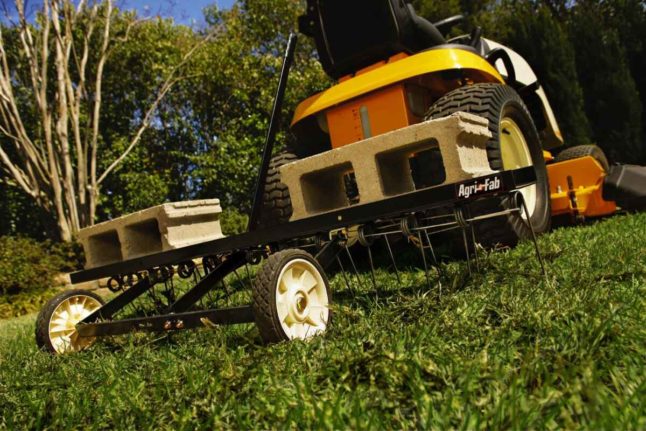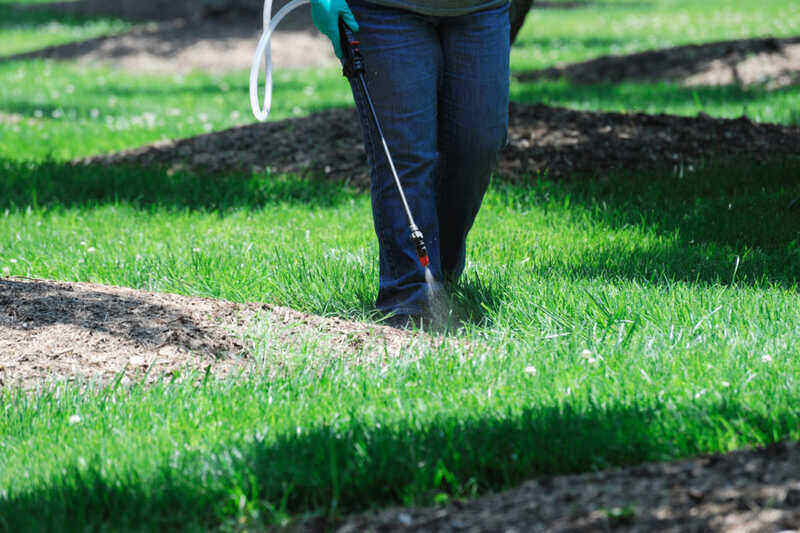
The grass isn’t always greener on the other side. But when it comes to your neighbor’s lawn, you can’t help but stare at their lush turfgrass and wonder, “Why is my neighbor’s yard greener than mine?” Well, here’s the inside scoop on their lawn care secrets.
Your neighbor may have installed an automated irrigation system, or maybe they don’t have dogs peeing in the same spots daily. Whatever the reason, we’ll look at many ways to green up your lawn.
In this article, we’ll cover 13 reasons why your neighbor may have a greener yard. Your neighbor likely:
- 1. Your neighbor waters the yard properly
- 2. Your neighbor has a different type of grass
- 3. Your neighbor mows appropriately
- 4. Your neighbor controls weeds
- 5. Your neighbor fertilizes the lawn
- 6. Your neighbor doesn’t let dogs go potty on the lawn
- 7. Your neighbor adds mulch to their lawn
- 8. Your neighbor aerates the soil
- 9. Your neighbor removes thatch
- 10. Your neighbor prevents bald patches
- 11. Your neighbor lengthens the lawn’s green period
- 12. Your neighbor gets rid of pests as soon as they appear
- 13. Your neighbor gets help from a professional
1. Your neighbor waters the yard properly

One of the reasons why your grass isn’t as green as your neighbor’s may be because of their watering methods. To get the upper hand, thoroughly water your grass less often but for extended periods to encourage healthy root growth.
Water 1 to 1.5 inches of water per week, ideally in the early morning so that the sun isn’t beating down on it immediately. In addition, avoid watering in the evening, as this can create an attractive moist environment for diseases.
You can also use a sprinkler with a wide spread to make sure that all parts of the lawn are getting watered evenly. If you want to be extra fancy, you can get an automated irrigation system to time your irrigation, reduce water runoff, and save you from having to wake up early to water your lawn.
Fun fact: Water is one of the most important parts of what makes grass green in the first place! You can’t keep your lawn green without giving it plenty to drink.
2. Your neighbor has a different type of grass
Don’t beat yourself up too much. Sometimes the only reason your neighbor’s grass is greener is that they have a different type of grass with a different shade of green and different growing habits.
Some grass varieties are more prone to growing tall and lush, while others are more likely to be short and dense. So even if you do the same lawn care your neighbor does, you probably won’t get the same results.
Turfgrass falls into one of two categories:
- Warm-season grasses like warm temperatures and actively grow in the summer. They are more common in the Southern states, and they enter dormancy in late autumn and green up in spring.
- Cool-season grasses like colder temperatures and actively grow in spring and fall. They are more common in the Northern states, entering dormancy in summer and when winters are frigid.
When you live in the middle of the country–the transition zone–you can grow both warm and cool-season grasses. So if you’re wondering why your neighbor has a green lawn in the summer while you don’t, they most likely have warm-season grass while you have cool-season turf.
3. Your neighbor mows appropriately

Your neighbor’s yard may be greener than yours because they mow their lawn using professional mowing methods. We know it’s tempting to mow short to extend the time between mowings, but this stresses the grass.
Your neighbor is probably following the rule of one-third: don’t mow more than one-third of your grass blades’ height in a single mow. That means that if your grass is 3 inches tall, you shouldn’t set your mower to cut off more than 1 inch, or you risk scalping your turf.
Another reason your neighbor might be excelling at mowing is that they keep their mower blades sharp. Dull mower blades will tear up more grass blades, leave a rougher finish, and make the lawn prone to disease, so ensure that yours are sharp before mowing.
4. Your neighbor controls weeds
Weeds are the bane of every lawn owner’s existence, but they’re especially problematic if you’re trying to achieve a greener lawn. They compete with your grass for water and nutrients, so getting rid of them is essential. Common lawn weeds include crabgrass, dandelions, and chickweed.
Here are some ways to get rid of them:
- Pre-emergent herbicides are popular weed killers applied to the soil before weeds germinate and prevent weeds from growing.
- Post-emergent herbicides are used after weeds have sprouted, killing them off quickly, so they don’t spread throughout your yard.
- Dig up weeds using a garden fork or a hand trowel, removing all of their root system for a chemical-free weed control method.
- Spray the weed with horticultural vinegar, but be careful not to spray the grass blades.
5. Your neighbor fertilizes the lawn
Every plant needs three primary nutrients: nitrogen, potassium, and phosphorus. So if your yard is not as green as your neighbor’s, it may be because it lacks one or more of those nutrients.
You can apply lawn fertilizer in two forms – liquid and granular. Liquid fertilizers are more easily absorbed, but they also don’t last long and must be applied more often. Granular fertilizers are slow-release, meaning they don’t act as fast, but they provide nutrients for longer.
For warm-season grasses, the best time to fertilize is in late spring through summer, and for cool-season grasses, in fall.
6. Your neighbor doesn’t let dogs go potty on the lawn
Having a dog is like having an unlimited source of unconditional love and affection. However, it’s also like having a pee factory in your home. Dog pee has high nitrogen levels, and although that is one of the main ingredients in fertilizer, too much nitrogen can turn your grass brown or even kill it.
So if you notice that your lawn has brown patches where your dog pees, try training them not to pee on the grass. If that doesn’t work, try washing out the area with water immediately after they do their business.
7. Your neighbor adds mulch to their lawn

Maybe it isn’t a matter of what you’re doing wrong but what your neighbor is doing right. For example, mulching is an effective way to improve the health of your lawn by adding organic material for soil nutrition, protecting it from dehydration, and preventing weeds.
You can easily add mulch to your lawn using grass clippings instead of throwing them away. Special blades can be attached to your regular lawn mower that will chop up the grass into smaller pieces and move them around your yard. These clippings eventually decompose, irrigating and giving nutrients to your lawn.
You can also mulch leaves by mowing over them a few times and spreading them in a thin layer in your yard. Each piece needs to be shredded to about ½ inch in size so they don’t block sunlight and oxygen from reaching the soil.
8. Your neighbor aerates the soil
In line with things your neighbor might be doing right, aeration is often overlooked by homeowners. Still, it can do wonders to compacted soil. The grass in your yard might be struggling because it isn’t getting enough oxygen, water, or nutrients as it could be.
To know if your lawn needs aeration, you can perform the screwdriver test. First, take a screwdriver and push it into your soil. If it goes without resistance, you probably don’t need to aerate yet, but if it’s hard to push in, consider aerating.
The best time of the year to aerate your soil is when the grass is in the growing period, that is, early spring to fall for cool-season grasses and late spring to summer for warm-season grasses.
9. Your neighbor removes thatch

Thatch is the organic matter layer between the soil and the grass blades. Some people say it’s like dandruff, but for your lawn. It’s healthy to have a thin layer of thatch, but if it gets thicker than one-half inch, it can be a problem.
A thick layer of thatch will prevent the soil from adequately absorbing water, fertilizer, mulch, or anything else you add, and it can become a breeding ground for pests and diseases. So consider dethatching during the turf’s growing period for a greener, lush look.
10. Your neighbor prevents bald patches
Have you ever struggled with a bald spot on your lawn? And have you wondered why your neighbor doesn’t have any? It may be because they’re overseeding the lawn to encourage new growth.
Overseeding is the process of spreading grass seeds across your lawn to make it look more dense and green. You can overseed your lawn once a year, preferably in spring if you have warm-season grass in your yard or in fall if you have cool-season grass.
Overseeding is better for preventing bald patches, but if you already have a large one, you’ll get faster results with grass plugs. Grass plugs are individual turf plants grown in trays, and they are ready to plant, unlike grass seeds, which can take a longer time to germinate.
11. Your neighbor lengthens the lawn’s green period
If you know your neighbor has warm-season grass but they still have a green period during winter, it might be because they’re overseeding their warm-season grass with cool-season annual or perennial ryegrass.
Warm-season grasses go dormant during winter, so if your neighbor has cool-season grass mixed in with their warm-season grass, they will get a more extended period of green lawn than you.
To get the upper hand, do the same process to your lawn and spread some cool-season annual or perennial ryegrass seeds.
12. Your neighbor gets rid of pests as soon as they appear

Pests annoy every homeowner, but some take too long to notice when they appear. Suppose your neighbor constantly monitors for pests on their lawn. In that case, they might have a greener lawn because they’re aware of what’s going on with pests and can take action early enough to keep them at bay.
There are various ways of dealing with pests, including pesticides or a more multi-faceted approach like Integrated Pest Management. Still, the most critical tip is to keep an eye on your lawn. Here are a few signs that you might have a pest on your lawn:
- Brown patches and brown spots
- Ragged blades
- Patches of bare soil
- Wilting grass blades
- Discoloration of individual turf blades
13. Your neighbor gets help from a professional
You pour your heart and soul into making your lawn greener and healthy. You spend hours mowing the grass, watering it, and feeding it to ensure you have the most beautiful lawn on the block. And yet, you still feel like your neighbor’s lawn is greener than yours.
Maybe your neighbor’s yard is greener simply because they get help from an expert in the field. Connect with a local lawn care professional to help get the most out of your lawn.
Main Image Credit: Pexels